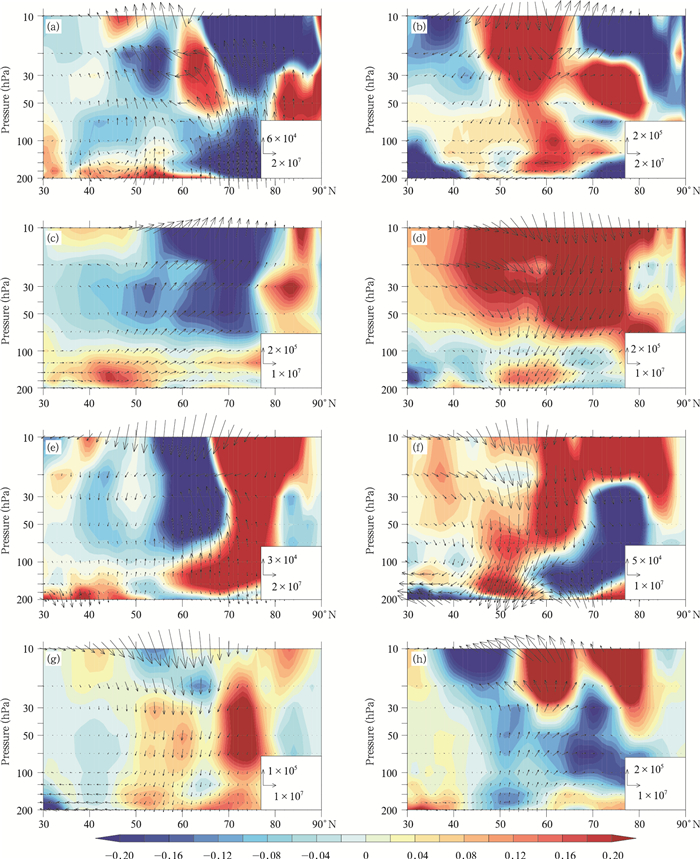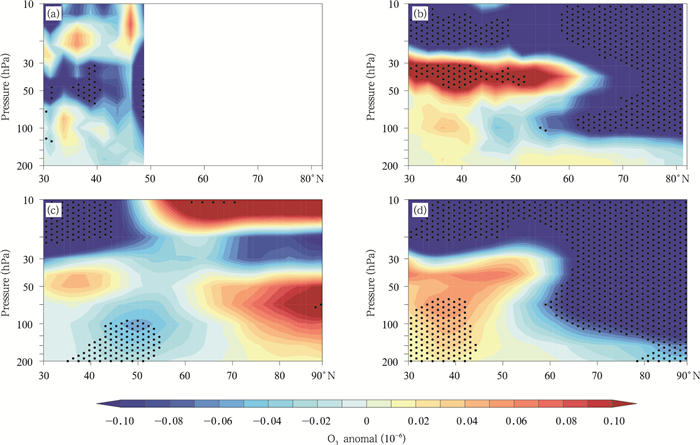中国气象学会主办。
文章信息
- 李小婷, 田文寿, 谢飞, 张如华, 雒佳丽, 梁靖琳. 2019.
- LI Xiaoting, TIAN Wenshou, XIE Fei, ZHANG Ruhua, LUO Jiali, LIANG Jinglin. 2019.
- 中部型ENSO和平流层准两年振荡对冬季北半球平流层臭氧的联合调制作用
- Joint impacts of ENSO Modoki and QBO on stratospheric ozone in winter in the Northern Hemisphere
- 气象学报, 77(3): 456-474.
- Acta Meteorologica Sinica, 77(3): 456-474.
- http://dx.doi.org/10.11676/qxxb2019.028
文章历史
-
2018-07-16 收稿
2018-11-03改回
2. 中国科学院大气物理研究所大气科学和地球流体力学数值模拟国家重点实验室, 北京, 100029;
3. 北京师范大学全球变化与地球系统科学研究院, 北京, 100875
2. State Key Laboratory of Numerical Modeling for Atmospheric Sciences and Geophysical Fluid Dynamics, Institute of Atmospheric Physics, Chinese Academy of Sciences, Beijing 100029, China;
3. College of Global Change and Earth System Science, Beijing Normal University, Beijing 100875, China
平流层臭氧作为平流层最重要的化学成分之一,不仅可以通过吸收紫外辐射来保护地球生物(Lubin, et al, 1995;Chipperfield, et al, 2015),也可以通过辐射和化学过程调节平流层温度和化学成分(吕达仁等, 2003, 2009;陈洪斌等,2006;胡永云,2006; 胡永云等, 2009;郑彬等,2007;陈月娟等,2009;施春华等, 2009, 2010;卞建春等,2011;张健恺等,2014;Haigh, 1994;Ramaswamy, et al, 1996;Chen, et al, 2008;Xie, et al, 2008;Hu, et al, 2009),进而影响平流层环流。平流层的环流异常则可以通过平流层-对流层耦合过程影响对流层的天气和气候(卞建春,2009;陈权亮等, 2007, 2009;郑彬等,2008;刘毅等,2009;陈文等, 2009, 2013;任荣彩等,2014;Cagnazzo, et al, 2009;Chen, et al, 2011; Li, et al, 2011;Reichler, et al, 2012;Ren, et al, 2014;Karpechko, et al, 2014;Kidston, et al, 2015;Zhang, et al, 2016)。自Farman等(1985)首次发现了南极臭氧空洞现象以来,已有大量的研究(Thompson et al, 2002, 2011;Gillett, et al, 2003;Son, et al, 2008;Feldstein, 2011;Kang, et al, 2011;Gerber, et al, 2014;Waugh, et al, 2015)表明,南极臭氧层的持续损耗会通过化学-辐射-动力耦合过程影响南半球对流层气候。北极平流层的臭氧损耗相较于南极平流层要小得多(WMO, 2011),但是,近年来一些观测研究(Lefèvre, et al, 1998;Manney, et al, 2011;Krzy s ' cin, 2012)表明,在个别年份北极平流层也出现了强度与南极相当的臭氧空洞。一些研究(Smith, et al, 2014;Calvo, et al, 2015;Xie et al, 2016, 2017;Ivy, et al, 2017)发现北极平流层臭氧的变化可以显著影响北半球气候变化。
平流层臭氧的变化主要受平流层溴、氯等臭氧消耗物质(ODS)浓度变化的影响(Ravishankara, et al, 2009;Eyring, et al, 2010;Zhang, et al, 2014;Kirner, et al, 2015)。北半球平流层臭氧的变化除了受到臭氧消耗物质的影响,其他一些气候因子也会显著地调节北半球平流层臭氧的变化,其中厄尔尼诺-南方涛动(ENSO)是控制平流层臭氧年际变率信号的主要因子之一(索春男等,2017;Xie et al, 2014a, 2014b;Zhang, et al, 2015;Li, et al, 2017)。ENSO可以通过调节平流层超长罗斯贝波的传播和耗散来影响平流层环流(Chen, et al, 2003; Garfinkel, et al, 2007; Ineson, et al, 2009)。研究已证实,在厄尔尼诺事件期间北极和中纬度地区出现了臭氧柱总量的异常升高(Brönnimann et al, 2004, 2006;Cagnazzo, et al, 2009),而拉尼娜事件期间,极地平流层臭氧的变化则相反(Free, et al, 2009;Mitchell, et al, 2011;Iza et al, 2015, 2016)。
热带平流层准两年振荡(QBO)是平流层中重要的动力过程。Randel等(2011)指出,除了ENSO之外,准两年振荡也是影响平流层臭氧的主要因子。已有研究表明,准两年振荡对北半球冬季极涡有一定的调制作用(Holton et al, 1980, 1982;Chen, et al, 1999;Wei, et al, 2007)。当赤道准两年振荡处于西风位相时,平流层中的行星波更多地向赤道传播,极涡更为强大稳定,极区温度更低;当赤道准两年振荡处于东风位相时,平流层中的行星波更多地向北极传播,极涡受扰动并减弱,这种准两年振荡对于极涡的调制作用被称作“Holton-Tan效应”。Reed(1964)提出准两年振荡引起的经向环流可以驱动臭氧柱总量出现准两年振荡信号。这是因为准两年振荡东风位相在热带下平流层诱发上涌,导致赤道臭氧柱总量出现负异常,而在准两年振荡西风位相,环流反转,导致臭氧柱总量出现正异常。近几十年,对平流层臭氧中准两年振荡信号的时、空特征以及准两年振荡影响臭氧的机制已有大量的研究(王春晓等,2017;Randel, et al, 1996;Butchart, et al, 2003;Tian, et al, 2006;Lee, et al, 2010)。
近些年来的研究发现了一类新的ENSO事件,与经典ENSO事件相比,与该类ENSO事件相关的海表温度异常中心主要位于赤道中太平洋地区(Ashok et al, 2007, 2009;Kao, et al, 2009;Kug, et al, 2009;Ren, et al, 2011;Wang, et al, 2013;陈圣劼等,2013),因而常被称为中部型ENSO(Ashok et al, 2007, 2009)。从20世纪80年代初以来,中部型ENSO事件的数量不断增加(Ashok et al, 2007, 2009;Yeh, et al, 2009),其对北极平流层的影响也受到了广泛的关注。Xie等(2012)指出,中部型ENSO对北半球中高纬度平流层纬向环流的影响完全不同于传统的ENSO事件:冬季中部型ENSO处于冷(暖)位相时,北半球极涡趋向于变强(变弱)。Xie等(2014a, 2014b)进一步研究表明从1980年到2010年,中部型ENSO是全球臭氧变化的关键因素,相比于传统的ENSO事件,中部型ENSO事件对热带平流层臭氧的影响更显著。综合来看,目前已有大量的研究分析了中部型ENSO和准两年振荡对北半球平流层环流、温度以及热带平流层臭氧的影响,但是关于中部型ENSO对北半球中高纬度平流层臭氧的影响研究比较少,特别是中部型ENSO和准两年振荡这两个重要的年际变率信号对北半球平流层臭氧的联合调制作用目前还没有明确的结论。深入研究中部型ENSO和准两年振荡对北半球平流层臭氧的综合影响,将有助于进一步理解北半球平流层臭氧的年际变化,并揭示相关机制。
2 资料和方法介绍采用的臭氧混合比资料分别来自SWOOSH (The Stratospheric Water and OzOne Satellite Homogenized)卫星资料和MERRA2(The second Modern-Era Retrospective analysis for Research and Applications)再分析资料。SWOOSH资料是将SAGE-Ⅱ资料同其他几种卫星观测资料(SAGE-/Ⅲ、UARS HALOE、UARS MLS和Aura MLS)拼接而成。该资料的时间跨度为1984年至今,包含有臭氧和水汽资料。文中使用1984—2016年SWOOSH纬向平均臭氧资料,水平分辨率为2.5°(纬度),垂直方向从316—1 hPa共31层,更多关于SWOOSH的资料见Davis等(2016)。MERRA2再分析资料由5.2.0版本的戈达德地球观测系统(GEOS-5)的大气模式和数据同化系统同化产生,文中使用的MERRA2资料水平分辨率为1.25°×1.25°,垂直方向上1000—0.1 hPa共42层。Wargan等(2017)指出,MERRA2再分析资料与卫星观测的臭氧结果相当,与MERRA1再分析资料相比,准两年振荡和平流层臭氧的代表性更好(Coy, et al, 2016)。使用的1984—2016年温度、位势高度以及水平风场(U、V)资料均来自ECMWF(European Center for Medium Range Weather Forecasting)再分析资料(ERA-Interim)。
文中使用中部型ENSO指数(EMI)来代表中部型ENSO事件的变化,其定义(Ashok, et al, 2007)为

|
(1) |
式中,[SSTA]C、[SSTA]E、[SSTA]W分别表示中太平洋区域(10°S—10°N,165°E—140°W)、东太平洋区域(15°S—5°N,110°—70°W)、西太平洋区域(10°S—20°N,125°—145°E)海温距平(SSTA)的面积平均值,计算中部型ENSO指数使用的海表温度来自于哈得来中心海温资料(Hadley Centre Sea-ice and Sea-surface Temperature Data Set Version1,HadISST1),水平分辨率是1°×1°,文中定义北半球冬季(12月—次年2月)EMI≥ +0.5℃为中部型厄尔尼诺年,相反地,EMI≤-0.5℃为中部型拉尼娜年。文中采用30 hPa纬向平均风来定义准两年振荡信号(Ribera, et al, 2004),即赤道地区(5°S—5°N) 30 hPa冬季纬向平均风小于-5 m/s时作为准两年振荡的东风位相(EQBO),大于5 m/s时作为准两年振荡西风位相(WQBO),其中纬向风速(U)采用1984—2016年ERA-Interim再分析资料。
Eliassen-Palm(E-P)通量及其散度目前被广泛用以描述行星波的传输和非线性破碎后产生的动量拖曳效应(Eliassen, et al, 1961;Andrews, et al, 1987)。地转近似下,球面p坐标系下E-P通量经向和垂直方向的矢量分别为

|
(2) |

|
(3) |
E-P通量散度的表达式为

|
(4) |
式中,a为地球半径,ρ0为大气密度,u、v、w分别表示纬向、经向和垂直速度分量;θ、f、φ分别表示位温、科里奥利参数和纬度;上标“—”“′”分别表示纬向平均和纬向偏差(涡动扰动),“θz”中的下标“z”表示对垂直坐标(气压)求偏导,计算E-P通量使用的U、V风场以及气温(T)均采用1984—2016年ERA-Interim再分析资料。
利用以下公式对位势高度场进行傅里叶分解从而得到行星1波和行星2波的情况。

|
(5) |
式中,F(u)为f(x)的像函数,f(x)为F(u)的像原函数。
图 1分别给出了冬季中部型ENSO指数和30 hPa高度层准两年振荡指数的时间序列,可以看出,中部型拉尼娜有明显的年代际变化特征(Yang, et al, 2017),从图 1选出中部型ENSO独立事件个例(表 1)、准两年振荡东、西风位相独立事件个例(表 2)以及中部型ENSO和准两年振荡联合事件个例(表 3)。文中得到各种事件对应的异常,均是根据以上3个表格并采用合成分析的方法得到的结果。此外,文中的异常均是指减去了1984—2016年的季节变化得到。

|
| 图 1 1984—2015年冬季平均的中部型ENSO指数(a)和30 hPa准两年振荡指数(b)的时间序列 Fig. 1 Time series of the EMI index (a) and QBO index at 30 hPa (b) from 1984-2015 in winter |
| 厄尔尼诺年 | 拉尼娜年 |
| 1990, 1994, 2002, 2004, 2009, 2014 | 1988, 1998, 1999, 2000, 2007, 2010, 2011 |
| 东风位相年 | 西风位相年 |
| 1986, 1988, 1989, 1991, 1993, 1995, 1996, 1997, 2000, 2002, 2003, 2005, 2007, 2009, 2011, 2012, 2014 |
1985, 1987, 1990, 1992, 1994, 1999, 2001, 2008, 2010, 2013, 2015 |
| 东风位相 | 西风位相 | ||
| 厄尔尼诺年 | 拉尼娜年 | 厄尔尼诺年 | 拉尼娜年 |
| 2002, 2009, 2014 | 1988, 2000, 2007, 2011 | 1990, 1994 | 1999, 2010 |
图 2分别给出了基于1984—2016年SWOOSH资料和MERRA2再分析资料合成的中部型厄尔尼诺年和中部型拉尼娜年冬季北半球纬向平均平流层臭氧的异常分布。在合成分析之前,臭氧中的准两年振荡信号已采用24—40个月的带通滤波方式滤除。由于热带太平洋对气候的影响在北半球冬季最为明显(Trenberth, et al, 2002;Seager, et al, 2010;Kosaka, et al, 2013),因此,文中仅讨论冬季(12月—次年2月)的情况。图 2中两种资料均显示,中部型厄尔尼诺事件期间北半球平流层大部分区域臭氧呈现出增加现象,可以看出SWOOSH资料和MERRA2再分析资料的结果也存在一些差异,如SWOOSH资料显示北半球平流层臭氧异常增加的高值区大致位于平流层10 hPa高度附近,而再分析资料结果显示北半球平流层臭氧异常增加的高值区主要位于中、下平流层。这种差异可能和两套资料的分辨率、资料同化方式等不同有一定关系。中部型拉尼娜年冬季北半球平流层臭氧则主要表现为减少的现象。导致北半球平流层臭氧的这种异常变化的可能原因是:中部型厄尔尼诺(中部型拉尼娜)活动增强(减弱)了平流层的行星波活动(图 6),导致北极极涡变暖减弱(变冷增强)(图 3),而北极极涡的变弱(变强)与Brewer Dobson(BD)环流的增强(减弱)相对应,导致更多(更少)的平流层臭氧从热带源区输送至高纬度地区。
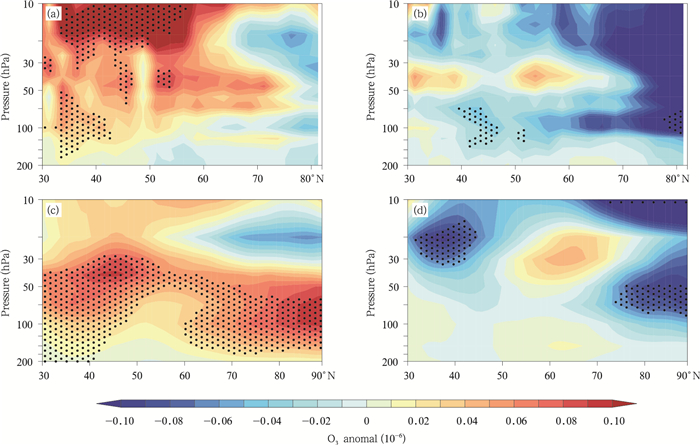
|
| 图 2 基于1984—2016年SWOOSH资料(a、b)和MERRA2再分析资料(c、d)合成的中部型厄尔尼诺年(a、c)和中部型拉尼娜年(b、d)冬季北半球纬向平均平流层臭氧异常的纬度-高度剖面 (黑点区域代表通过了95%显著性水平t检验;合成方法采用的个例见表 1) Fig. 2 Latitude-height cross-sections of composite anomalies of zonal mean stratospheric ozone in the NH in winter for El Niño Modoki events (a, c) and La Niña Modoki events (b, d) based on SWOOSH (a, b) and MERRA2 (c, d) data from 1984-2016 (Anomalies that are significant at the 95% confidence level (Student's t-test) are dotted. The selected events for composite analysis are listed in Table 1) |
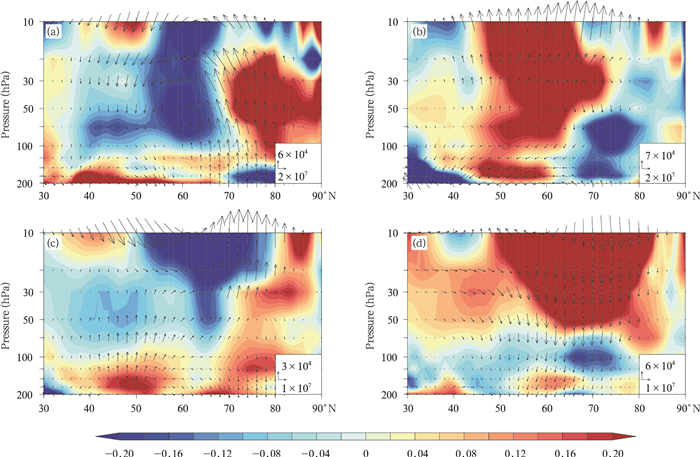
|
| 图 6 基于1984—2016年ERA-Interim再分析资料合成的中部型厄尔尼诺事件(a)和中部型拉尼娜事件(b)冬季北半球纬向平均E-P通量异常的纬度-高度剖面(色阶为E-P通量散度(单位:m/(s·d)),箭头为E-P通量水平和垂直分量(水平分量单位:m3/s2,垂直分量单位:Pa·m2/s2),合成方法采用的个例见表 1;在进行合成分析之前,采用24—40个月的带通滤波去除了准两年振荡信号);(c)、(d)同(a)、(b),但为准两年振荡东风位相(c)和西风位相(d)的情况 (合成方法采用的个例见表 2;在进行合成分析之前,采用回归方法去除了中部型ENSO信号) Fig. 6 Latitude-height cross-sections of composite anomalies of the E-P flux (vectors, normalized by air density; unit: m3/s2) and E-P flux divergence (color shadings, unit: m/(s·d)) for El Niño Modoki events (a) and La Niña Modoki events (b) based on ERA-interim data from 1984-2016 (The selected events are listed in Table 1. Before the composite analysis is conducted, the QBO signal has been filtered out from the time series using a 24-40 month band-pass filter); (c) and (d) are the same as (a) and (b), but for the the EQBO phase and WQBO phase, respectively (The selected events are listed in Table 2. Before the composite analysis is conducted, the ENSO Modoki signal in the ozone has been removed by regression) |

|
| 图 3 基于1984—2016年ERA-Interim再分析资料合成的中部型厄尔尼诺年(a、c)和中部型拉尼娜年(b、d)冬季北半球纬向平均平流层温度(a、b)和纬向风速(c、d)的纬度-高度剖面 (说明同图 2) Fig. 3 Latitude-height cross-sections of composite anomalies of zonal mean temperature (a, b) and zonal wind (c, d) in winter for El Niño Modoki events (a, c) and La Niña Modoki events (b, d) based on ERA-Interim data from 1984-2016 (Same as Fig. 2) |
图 4给出了基于1984—2016年SWOOSH观测资料和MERRA2再分析资料合成的准两年振荡东风位相和西风位相冬季北半球纬向平均平流层臭氧异常。在合成分析之前,臭氧中的中部型ENSO信号已通过回归方式去除。可以看出,在准两年振荡东风位相年份,冬季北半球平流层臭氧增加,而在西风位相年份北半球平流层臭氧减少,这与已有的研究结果(Randel, et al, 1996;Butchart, et al, 2003;Tian, et al, 2006;Lee, et al, 2010)是一致的。SWOOSH资料结果表明,北半球平流层臭氧异常减少的大值区主要位于中下平流层,而MERRA2再分析资料结果显示北半球平流层臭氧异常减少的大值区主要位于上平流层。进一步分析北半球纬向平均平流层温度和纬向风速发现,在准两年振荡东风位相(西风位相)年份,BD环流增强(减弱),北极极涡变暖减弱(变冷增强)(图 5),增强(减弱)的BD环流将更多(更少)的平流层臭氧从热带平流层输送到高纬度平流层。这就导致了准两年振荡东风位相年份引起的北半球中高纬度平流层臭氧的增加和西风位相年份引起的北半球平流层臭氧的减少。对比图 2、4可见,中部型ENSO活动引起的北半球中高纬度平流层臭氧变化明显大于准两年振荡造成的变化。
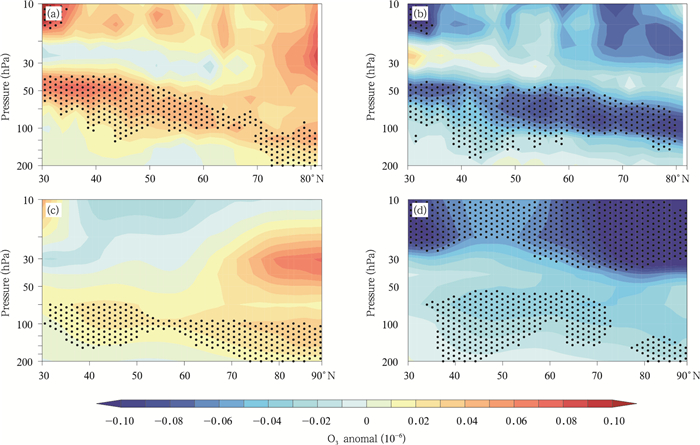
|
| 图 4 基于1984—2016年SWOOSH资料(a、b)和MERRA2再分析资料(c、d)合成的准两年振荡东风位相(a、c)和西风位相(b、d)冬季北半球纬向平均平流层臭氧异常的纬度-高度剖面 (黑点区域代表通过了95%显著性水平t检验;合成方法采用的个例见表 2) Fig. 4 Latitude-height cross-sections of composite anomalies of zonal mean stratospheric ozone in the NH in winter for the EQBO phase (a, c) and the WQBO phase (b, d) based on SWOOSH (a, b) and MERRA2 (c, d) data from 1984-2016 (The selected events are listed in Table 2. Anomalies that are significant at the 95% confidence level (Student's t-test) are dotted) |

|
| 图 5 基于1984—2016年ERA-Interim再分析资料合成的准两年振荡东风位相(a、c)和西风位相(b、d)冬季北半球纬向平均平流层温度(a、b)和纬向风速(c、d)的纬度-高度剖面 (说明同图 4) Fig. 5 Latitude-height cross-sections of composite anomalies of zonal mean temperature (a, b) and zonal wind (c, d) in winter for the EQBO phase (a, c) and the WQBO phase (b, d) based on ERA-Interim data from 1984-2016 (Same as Fig. 4) |
上述结果表明,中部型ENSO和准两年振荡活动会影响冬季北极极涡的温度和强度,进而对北半球平流层臭氧产生影响。黎成超等(2016)研究也指出极涡强度的变化能直接影响到冬季北极平流层臭氧的异常分布,冬季北极平流层臭氧总量与极涡强度有很好的负相关关系,即:极涡强度弱时,上传到平流层的涡动热通量强,北半球中高纬度地区E-P通量散度辐合增强,BD环流加强,将导致该地区得到低纬度含高浓度臭氧空气的补充而使臭氧含量升高。已有研究也指出,行星波扰动对极涡强度变化有直接的贡献,而ENSO的异常变化和准两年振荡活动对行星波的扰动起到重要的作用(Van Loon, et al, 1982;Labitzke, et al, 1989;Manzini, et al, 2006;García-Herrera, et al, 2006;Camp, et al, 2007;Xie et al, 2012, 2014a, 2014b;Zhang et al, 2014, 2015)。因此,接下来将探讨中部型ENSO冷、暖位相和准两年振荡东、西风位相年,北半球中高纬度平流层行星波活动的变化。
E-P通量是球面大气中的波作用通量,可用来表征行星波的传播。图 6给出了1984—2016年基于中部型厄尔尼诺和中部型拉尼娜事件(图 6a、b)以及准两年振荡东风位相和西风位相(图 6c、d)合成的北半球中高纬度E-P通量垂直、水平分量以及E-P通量散度异常的纬度-高度分布(计算方法见第2节)。由图 6a、b可以看出,中部型厄尔尼诺事件北半球中高纬度E-P通量异常增加,对应中高纬度E-P通量辐合增强,这代表进入平流层的行星波会更多。中部型拉尼娜事件北半球中高纬度E-P通量异常减少,对应冬季北半球中高纬度E-P通量辐散增强,这代表进入平流层的行星波会更少。从图 6c、d可以看出,在准两年振荡东风位相年北半球中高纬度下平流层E-P通量异常辐散,平流层中层E-P通量异常辐合,说明准两年振荡东风位相年更多的行星波进入平流层,而准两年振荡西风位相年E-P通量的变化正好相反。由于冬季影响平流层的主要波动是行星1波和行星2波(Huang et al, 2017, 2018),因此,图 7进一步给出了中部型ENSO事件和准两年振荡不同位相行星1波和行星2波的E-P通量变化。可见中部型厄尔尼诺事件和准两年振荡东风位相时期,北半球中纬度平流层行星1波增强,行星2波减弱,中部型拉尼娜事件和准两年振荡西风位相时期,结果则相反。
为了研究中部型ENSO事件和准两年振荡引起的向平流层传播的对流层行星波的垂直结构,将通过对45°—75°N加权平均的位势高度场沿纬圈进行傅里叶分解(具体分解见第2节),合成了中部型ENSO事件和准两年振荡相位时期,冬季行星1波和行星2波的经度-高度剖面(图 8)。可见中部型厄尔尼诺事件期间行星1波的响应与气候态行星1波是同位相叠加的(图 8a),行星2波则是反位相叠加的(图 8e),这意味着中部型厄尔尼诺的作用导致冬季北半球中高纬度行星1波增强,行星2波减弱;相反地,中部型拉尼娜事件期间行星1波的响应与气候态行星1波反位相叠加(图 8b),行星2波是同位相叠加(图 8f),表明中部型拉尼娜事件的作用导致冬季北半球中高纬度行星1波减弱,行星2波增强。同样的,可以看出准两年振荡东风位相期间行星1波的响应与气候态行星1波是同位相叠加的(图 8c),行星2波则是反位相叠加的(图 8g)。即准两年振荡东风位相的作用导致冬季北半球中高纬度行星1波增强,行星2波减弱;相反地,准两年振荡西风位相期间行星1波的响应与气候态行星1波反位相叠加(图 8d),行星2波同位相叠加(图 8h),表明准两年振荡西风位相的作用导致冬季北半球中高纬度行星1波减弱,行星2波增强。
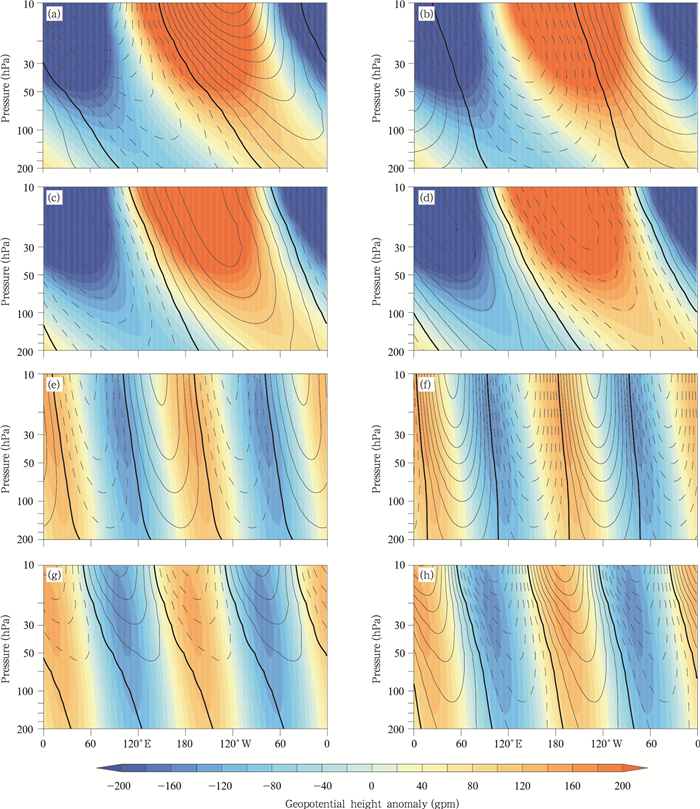
|
| 图 8 基于1984—2016年ERA-Interim再分析资料合成的中部型厄尔尼诺事件(a)、中部型拉尼娜事件(b)冬季45°—75°N平均的行星1波位势高度异常场(等值线为位势高度异常值,实线为正异常,虚线为负异常,粗实线为0线,单位:gpm)的经度-高度剖面(合成方法采用的个例见表 1,在进行合成分析之前,采用24—40个月的带通滤波去除了准两年振荡信号);(c)、(d)同(a)、(b),但为准两年振荡东风位相(c)和西风位相(d)的情况(合成方法采用的个例见表 2,在进行合成分析之前,采用回归方法去除了中部型ENSO信号);(e)—(h)同(a)—(d),但为冬季平均波数为行星2波(色阶为气候态值) Fig. 8 Longitude-height cross-sections of composite anomalies of geopotential height of wave-1 at 45°-75°N for El Niño Modoki events (a) and La Niña Modoki events (b) based on ERA-interim data from 1984-2016 (Shadings show the climatological (stationary) wave-1 field. The selected events are listed in Table 1. Before the composite analysis is conducted, the QBO signal has been filtered out from the time series using a 24-40 month band-pass filter); (c) and (d) are the same as (a) and (b) but for the EQBO phase and the WQBO phase, respectively (The selected events are listed in Table 2. Before the composite analysis is conducted, the ENSO signal in the ozone has been removed by regression); (e)-(h) are the same as (a)-(d) but for planetary wave-2 |
以上讨论了中部型ENSO和准两年振荡对北半球平流层臭氧的独立影响,以下将继续讨论中部型ENSO和准两年振荡事件对冬季北半球平流层臭氧的联合影响。图 9给出了基于SWOOSH资料和MERRAE2再分析资料合成的准两年振荡东风位相下中部型厄尔尼诺事件(图 9a、c)和中部型拉尼娜事件(图 9b、d)时期冬季北半球纬向平均平流层臭氧异常的纬度-高度分布。对比图 2可知,准两年振荡东风位相增大了中部型厄尔尼诺事件造成的冬季北半球平流层臭氧的正异常;而中部型拉尼娜事件对冬季北半球平流层臭氧的负异常则变小了。因此,准两年振荡东风位相会加强中部型厄尔尼诺事件对冬季北半球平流层臭氧的影响,而减弱中部型拉尼娜事件对其的影响。图 10给出了准两年振荡西风位相下中部型厄尔尼诺事件(图 10a、c)和中部型拉尼娜事件(图 10b、d)期间冬季北半球平流层臭氧异常的纬度-高度分布。在准两年振荡西风位相的影响下,中部型厄尔尼诺事件造成的北半球平流层臭氧增加量变得很小;而在中部型拉尼娜事件期间,北半球平流层臭氧的减少则变得更为明显。因此,准两年振荡西风位相可能会减弱中部型厄尔尼诺而加强中部型拉尼娜事件对冬季北半球平流层臭氧的影响。

|
| 图 9 基于1984—2016年SWOOSH资料(a、b)和MERRA2资料(c、d)合成的准两年振荡东风位相下中部型厄尔尼诺年(a、c)、中部型拉尼娜年(b、d)冬季北半球纬向平均平流层臭氧异常的纬度-高度剖面 (合成方法采用的个例见表 3,黑点区域代表通过了95%显著性水平t检验) Fig. 9 Latitude-height cross-sections of composite anomalies of zonal mean ozone for El Niño Modoki (a, c) and La Niña Modoki (b, d) events under the phase of QBO based on SWOOSH (a, b) and MERRA2 (c, d) data from1984-2016 (The selected events are listed in Table 3. Anomalies that are significant at the 95% confidence level (Student's t-test) are dotted) |
图 11、12给出了基于SWOOSH观测资料和MERRA2再分析资料合成的冬季北半球平流层准两年振荡东风位相和西风位相期间臭氧异常分别与中部型厄尔尼诺事件和中部型拉尼娜事件期间的臭氧异常之和。从图 11、12也可以得出与图 9、10相同的结论,只是臭氧异常值的大小有差异,但幅度不大。通过以上分析表明,中部型ENSO和准两年振荡对冬季北半球平流层臭氧的联合作用近似等于中部型ENSO和准两年振荡的独立影响的线性叠加。从另一个角度思考,在中部型ENSO事件的影响下,准两年振荡东西风位相对冬季北半球平流层臭氧又有什么不同的影响呢?对比图 3、9和10可以推测,中部型ENSO事件可以通过影响上传行星波来调节准两年振荡对北极极涡的影响(Wei, et al, 2007),即中部型厄尔尼诺事件加强了准两年振荡东风位相对冬季北半球平流层臭氧的影响,而减弱了西风位相对其的影响;中部型拉尼娜事件的存在,使得准两年振荡东风位相对冬季北半球平流层臭氧的影响减弱,而其西风位相对冬季北半球平流层臭氧的影响加强。

|
| 图 11 基于1984—2016年SWOOSH资料(a、b)和MERRA2资料(c、d)合成的准两年振荡东风位相下冬季北半球纬向平均平流层臭氧异常分别与中部型厄尔尼诺年(a、c)、中部型拉尼娜年(b、d)冬季北半球平流层臭氧异常之和的纬度-高度剖面 (合成方法采用的个例见表 1和表 2,黑点区域代表通过了95%显著性水平t检验) Fig. 11 Latitude-height cross-sections of sums of composite anomalies of zonal mean stratospheric ozone in the NH in winter during EQBO phase and El Niño Modoki events (a, c) or La Niña Modoki (b, d) events based on SWOOSH (a, b) and MERRA2 (c, d) data from1984-2016 (Anomalies that are significant at the 95% confidence level (Student's t-test) are dotted. The selected events for composite analysis are listed in Table 1 and Table 2) |
利用SWOOSH卫星资料以及MERRA2再分析资料通过合成分析的方法,研究了中部型ENSO和准两年振荡对冬季北半球平流层臭氧的独立影响,并分析了两者对冬季北半球平流层臭氧的联合调制作用,得到以下几点主要的结论:
(1) 中部型ENSO活动可以通过调节平流层超长罗斯贝波的传播和耗散来影响平流层环流,进而影响到北极平流层极涡的温度和强度,最终导致冬季北半球平流层臭氧发生异常变化,即北半球平流层臭氧在中部型厄尔尼诺年增加,而在中部型拉尼娜年减少。在准两年振荡东(西)风位相年份,北半球平流层臭氧增加(减少)。对比中部型ENSO和准两年振荡对北半球平流层臭氧的影响,发现北半球中高纬度平流层臭氧异常对准两年振荡位相的响应小于对中部型ENSO活动的响应。
(2) 准两年振荡东风位相加强了中部型厄尔尼诺事件造成的北半球平流层臭氧的正异常,而减弱了中部型拉尼娜事件对北半球平流层臭氧的负异常。因此,准两年振荡东风位相会加强中部型厄尔尼诺事件对北半球平流层臭氧的影响,而减弱中部型拉尼娜事件对北半球平流层臭氧的影响。在准两年振荡西风位相的影响下,中部型厄尔尼诺事件造成的北半球平流层臭氧增加量变得更微弱,而在中部型拉尼娜事件期间北半球平流层臭氧的减少则变得更为明显。因此,准两年振荡西风位相可能会减弱中部型厄尔尼诺而加强中部型拉尼娜事件对北半球平流层臭氧的影响。
| 卞建春. 2009. 上对流层/下平流层大气垂直结构研究进展. 地球科学进展, 24(3): 262–271. Bian J C. 2009. Recent advances in the study of atmospheric vertical structures in upper troposphere and lower stratosphere. Adv Earth Sci, 24(3): 262–271. DOI:10.3321/j.issn:1001-8166.2009.03.005 (in Chinese) |
| 卞建春, 严仁嫦, 陈洪滨. 2011. 亚洲夏季风是低层污染物进入平流层的重要途径. 大气科学, 35(5): 897–902. Bian J C, Yan R C, Chen H B. 2011. Tropospheric pollutant transport to the stratosphere by Asian summer monsoon. Chinese J Atmos Sci, 35(5): 897–902. DOI:10.3878/j.issn.1006-9895.2011.05.09 (in Chinese) |
| 陈洪滨, 卞建春, 吕达仁. 2006. 上对流层-下平流层交换过程研究的进展与展望. 大气科学, 30(5): 813–820. Chen H B, Bian J C, Lü D R. 2006. Advances and prospects in the study of Stratosphere-Troposphere Exchange. Chinese J Atmos Sci, 30(5): 813–820. DOI:10.3878/j.issn.1006-9895.2006.05.10 (in Chinese) |
| 陈权亮, 陈月娟. 2007. 平流层剩余环流及其时间演变特征. 大气科学, 31(1): 137–144. Chen Q L, Chen Y J. 2007. Stratospheric residual circulation and its temporal and spatial evolution. Chinese J Atoms Sci, 31(1): 137–144. (in Chinese) |
| 陈权亮, 任景轩, 范广洲, 等. 2009. 行星波波动对平流层剩余环流的影响. 高原气象, 28(2): 402–410. Chen Q L, Ren J X, Fan G Z, et al. 2009. Impact of planetary wave on the stratospheric residual circulation. Plateau Meteor, 28(2): 402–410. (in Chinese) |
| 陈圣劼, 何金海, 吴志伟. 2013. 一种新的El Niño海气耦合指数. 大气科学, 37(4): 815–828. Chen S J, He J H, Wu Z W. 2013. New ocean-atmosphere coupling indices for El Niño. Chinese J Atmos Sci, 37(4): 815–828. (in Chinese) |
| 陈文, 魏科. 2009. 大气准定常行星波异常传播及其在平流层影响东亚冬季气候中的作用. 地球科学进展, 24(3): 272–285. Chen W, Wei K. 2009. Anomalous propagation of the quasi-stationary planetary waves in the atmosphere and its roles in the impact of the stratosphere on the East Asian winter climate. Adv Earth Sci, 24(3): 272–285. DOI:10.3321/j.issn:1001-8166.2009.03.006 (in Chinese) |
| 陈文, 魏科, 王林, 等. 2013. 东亚冬季风气候变异和机理以及平流层过程的影响. 大气科学, 37(2): 425–438. Chen W, Wei K, Wang L, et al. 2013. Climate variability and mechanisms of the East Asian winter monsoon and the impact from the stratosphere. Chinese J Atmos Sci, 37(2): 425–438. (in Chinese) |
| 陈月娟, 易明建, 毕云, 等. 2009. 平流层微量气体变化趋势的研究. 地球科学进展, 24(3): 308–319. Chen Y J, Yi M J, Bi Y, et al. 2009. A study of the trends of the trace gases in stratosphere. Adv Earth Sci, 24(3): 308–319. DOI:10.3321/j.issn:1001-8166.2009.03.009 (in Chinese) |
| 胡永云. 2006. 平流层极地臭氧损耗影响对流层气候的研究进展. 北京大学学报(自然科学版), 42(5): 561–568. Hu Y Y. 2006. Possible impact of stratospheric polar ozone depletion on tropospheric climate. Acta Sci Natural Univ Pekin, 42(5): 561–568. DOI:10.3321/j.issn:0479-8023.2006.05.001 (in Chinese) |
| 胡永云, 丁峰, 夏炎. 2009. 全球变化条件下的平流层大气长期变化趋势. 地球科学进展, 24(3): 242–251. Hu Y Y, Ding F, Xia F. 2009. Stratospheric climate trends under conditions of global climate changes. Adv Earth Sci, 24(3): 242–251. DOI:10.3321/j.issn:1001-8166.2009.03.003 (in Chinese) |
| 黎成超, 郭世昌, 易琦, 等. 2016. 北半球中高纬地区冬季大气臭氧与极涡强度关系. 高原气象, 35(5): 1290–1297. Li C C, Guo S C, Yi Q, et al. 2016. Relationship between atmospheric ozone and polar vortex intensity in the mid-high latitude over the Northern Hemisphere in winter. Plateau Meteor, 35(5): 1290–1297. (in Chinese) |
| 刘毅, 刘传熙. 2009. 利用WACCM-3模式对平流层动力、热力场及微量化学成分季节变化的数值模拟研究. 空间科学学报, 29(6): 580–590. Liu Y, Liu C X. 2009. Simulation studies on seasonal variations of the stratospheric dynamics and trace gases using coupled chemistry-climate model WACCM-3. Chinese J Space Sci, 29(6): 580–590. (in Chinese) |
| 吕达仁, 陈洪滨. 2003. 平流层和中层大气研究的进展. 大气科学, 27(4): 750–769. DOI:10.3878/j.issn.1006-9895.2003.04.21 |
| Lü D R, Chen H B. 2007. Advances in middle atmosphere physics research. Chinese J Atmos Sci, 27(4): 750–769. |
| 吕达仁, 卞建春, 陈洪滨, 等. 2009. 平流层大气过程研究的前沿与重要性. 地球科学进展, 24(3): 221–227. Lü D R, Bian J C, Chen H B, et al. 2009. Frontiers and significance of research on stratospheric processes. Adv Earth Sci, 24(3): 221–227. DOI:10.3321/j.issn:1001-8166.2009.03.001 (in Chinese) |
| 任荣彩, 吴国雄, CaiMing, 等. 2014. 平流层-对流层相互作用研究进展:等熵位涡理论的应用及青藏高原影响. 气象学报, 72(5): 853–868. Ren R C, Wu G X, Cai M, et al. 2014. Progress in research of stratosphere-troposphere interactions:Application of isentropic potential vorticity dynamics and the effects of the Tibetan Plateau. Acta Meteor Sinica, 72(5): 853–868. (in Chinese) |
| 施春华, 郑彬, 陈月娟, 等. 2009. 热带平流层水汽的准两年周期振荡. 地球物理学报, 52(10): 2428–2435. Shi C H, Zheng B, Chen Y J, et al. 2009. The quasi-biennial oscillation of water vapor in tropic stratosphere. Chinese J Geophys, 52(10): 2428–2435. DOI:10.3969/j.issn.0001-5733.2009.10.002 (in Chinese) |
| 施春华, 陈月娟, 郑彬, 等. 2010. 平流层臭氧季节变化的动力和光化学作用之比较. 大气科学, 34(2): 399–406. Shi C H, Chen Y J, Zheng B, et al. 2010. A comparison of the contributions of dynamical transportation and photochemical process to ozone's seasonal variation in the stratosphere. Chinese J Atmos Sci, 34(2): 399–406. DOI:10.3878/j.issn.1006-9895.2010.02.13 (in Chinese) |
| 索春男, 田文寿, 谢飞, 等. 2017. 1997年和2011年春季北极臭氧损耗事件的对比分析. 气象学报, 75(3): 492–505. Suo C N, Tian W S, Xie F, et al. 2017. A comparative analysis of Arctic ozone depletion events in the spring of 1997 and 2011. Acta Meteor Sinica, 75(3): 492–505. (in Chinese) |
| 王春晓, 田文寿. 2017. 热带平流层CO浓度准两年振荡的位相变化特征. 大气科学, 41(2): 275–288. Wang C X, Tian W S. 2017. Phase change in quasi-biennial oscillation in the tropical stratospheric carbon monoxide concentration. Chinese J Atmos Sci, 41(2): 275–288. (in Chinese) |
| 张健恺, 刘玮, 韩元元, 等. 2014. 平流层臭氧变化对对流层气候影响的研究进展. 干旱气象, 32(5): 685–693. Zhang J K, Liu W, Han Y Y, et al. 2014. Progresses in influence of variations in stratospheric ozone on tropospheric climate. J Arid Meteor, 32(5): 685–693. (in Chinese) |
| 郑彬, 谷德军, 林爱兰, 等. 2007. 平流层准两年变化对南海夏季风影响机制的探讨. 中国科学D辑:地球科学, 50(9): 1424–1432. Zheng B, Gu D J, Lin A L, et al. 2007. Dynamical mechanism of the stratospheric quasi-biennial oscillation impact on the South China Sea Summer Monsoon. Sci China Ser D:Earth Sci, 50(9): 1424–1432. (in Chinese) |
| 郑彬, 施春华. 2008. 平流层准两年周期振荡对CH4双峰的影响. 热带气象学报, 24(2): 111–116. Zheng B, Shi C H. 2008. An influence of quasi-biennial oscillation on the double peaks of CH4 in the stratosphere. J Trop Meteor, 24(2): 111–116. DOI:10.3969/j.issn.1004-4965.2008.02.002 (in Chinese) |
| Andrews D G, Holton J R, Leovy C B. 1987. Middle Atmosphere Dynamics. San Diego: Academic press. |
| Ashok K, Behera S K, Rao S A, et al. 2007. El Niño Modoki and its possible teleconnection. J Geophys Res, 112(C11): C11007. DOI:10.1029/2006JC003798 |
| Ashok K, Yamagata T. 2009. The El Niño with a difference. Nature, 461(7263): 481–484. DOI:10.1038/461481a |
| Brönnimann S, Luterbacher J, Staehelin J, et al. 2004. Extreme climate of the global troposphere and stratosphere in 1940-42 related to El Niño. Nature, 431(7011): 971–974. DOI:10.1038/nature02982 |
| Brönnimann S, Schraner M, Müller B, et al. 2006. The 1986-1989 ENSO cycle in a chemical climate model. Atmos Chem Phys, 6(12): 4669–4685. |
| Butchart N, Scaife A A, Austin J, et al. 2003. Quasi-biennial oscillation in ozone in a coupled chemistry-climate model. J Geophys Res Atmos, 108(D15): 4486. DOI:10.1029/2002JD003004 |
| Cagnazzo C, Manzini E, Calvo N, et al. 2009. Northern winter stratospheric temperature and ozone responses to ENSO inferred from an ensemble of chemistry climate models. Atmos Chem Phys, 9(22): 8935–8948. DOI:10.5194/acp-9-8935-2009 |
| Cagnazzo C, Manzini E. 2009. Impact of the stratosphere on the Winter Tropospheric Teleconnections between ENSO and the North Atlantic and European Region. J Climate, 22(5): 1223–1238. DOI:10.1175/2008JCLI2549.1 |
| Calvo N, Polvani L M, Solomon S. 2015. On the surface impact of Arctic stratospheric ozone extremes. Environ Res Lett, 10(9): 094003. DOI:10.1088/1748-9326/10/9/094003 |
| Camp C D, Tung K K. 2007. Stratospheric polar warming by ENSO in winter:A statistical study. Geophys Res Lett, 34(4): L04809. |
| Chen Q L, Li Z, Fan G Z, et al. 2011. Indications of stratospheric anomalies in the freezing rain and snow disaster in South China, 2008. Sci China Earth Sci, 54(8): 1248–1256. DOI:10.1007/s11430-011-4192-3 |
| Chen W, Huang R H. 1999. The modulation of planetary wave propagation by the tropical QBO zonal winds and the associated effects in the residual meridional circulation. Contrib Atmos Phys, 72(2): 187–204. |
| Chen W, Takahashi M, Graf H F. 2003. Interannual variations of stationary planetary wave activity in the northern winter troposphere and stratosphere and their relations to NAM and SST. J Geophys Res, 108(D24): 4797. |
| Chen Z Y, Chen H B, Chen W, et al. 2008. Advances in the researches in middle and upper atmosphere in 2006-2008. Chinese J Space Sci, 28(5): 412–423. |
| Chipperfield M P, Dhomse S S, Feng W, et al. 2015. Quantifying the ozone and ultraviolet benefits already achieved by the Montreal Protocol. Nat Commun, 6: 7233. DOI:10.1038/ncomms8233 |
| Coy L, Wargan K, Molod A M, et al. 2016. Structure and dynamics of the quasi-biennial oscillation in MERRA-2. J Climate, 29(14): 5339–5354. DOI:10.1175/JCLI-D-15-0809.1 |
| Davis S M, Rosenlof K H, Hassler B, et al. 2016. The stratospheric water and ozone satellite homogenized (SWOOSH) database:A long-term database for climate studies. Earth Syst Sci Data, 8(2): 461–490. DOI:10.5194/essd-8-461-2016 |
| Eliassen A, Palm E. 1961. On the transfer of energy in stationary mountain waves. Geofys Publ, 22(3): 1–23. |
| Eyring V, Cionni I, Bodeker G E, et al. 2010. Multi-model assessment of stratospheric ozone return dates and ozone recovery in CCMVal-2 models. Atmos Chem Phys, 10(19): 9451–9472. DOI:10.5194/acp-10-9451-2010 |
| Farman J C, Gardiner B G, Shanklin J D. 1985. Large losses of total ozone in Antarctica reveal seasonal ClOx/NOx interaction. Nature, 315(6016): 207–210. DOI:10.1038/315207a0 |
| Feldstein S B. 2011. Subtropical rainfall and the Antarctic ozone hole. Science, 332(6032): 925–926. DOI:10.1126/science.1206834 |
| Free M, Seidel D J. 2009. Observed El Niño-Southern Oscillation temperature signal in the stratosphere. J Geophys Res, 114(D23): D23108. DOI:10.1029/2009JD012420 |
| García-Herrera R, Calvo N, Garcia R R, et al. 2006. Propagation of ENSO temperature signals into the middle atmosphere:A comparison of two general circulation models and ERA-40 reanalysis data. J Geophys Res, 111(D6): D06101. |
| Garfinkel C I, Hartmann D L. 2007. Effects of the El Niño-Southern Oscillation and the quasi-biennial oscillation on polar temperatures in the stratosphere. J Geophys Res, 112(D19): D19112. DOI:10.1029/2007JD008481 |
| Gerber E P, Son S W. 2014. Quantifying the summertime response of the Austral Jet Stream and Hadley Cell to stratospheric ozone and greenhouse gases. J Climate, 27(14): 5538–5559. DOI:10.1175/JCLI-D-13-00539.1 |
| Gillett N P, Thompson D W J. 2003. Simulation of recent Southern Hemisphere climate change. Science, 302(5643): 273–275. DOI:10.1126/science.1087440 |
| Haigh J D. 1994. The role of stratospheric ozone in modulating the solar radiative forcing of climate. Nature, 370(6490): 544–546. DOI:10.1038/370544a0 |
| Holton J R, Tan H C. 1980. The influence of the equatorial quasi-biennial oscillation on the global circulation at 50 mb. J Atmos Sci, 37(10): 2200–2208. DOI:10.1175/1520-0469(1980)037<2200:TIOTEQ>2.0.CO;2 |
| Holton J R, Tan H C. 1982. The quasi-biennial oscillation in the Northern Hemisphere lower stratosphere. J Meteor Soc Jpn, 60: 140–148. DOI:10.2151/jmsj1965.60.1_140 |
| Hu Y Y, Pan L F. 2009. Arctic stratospheric winter warming forced by observed SSTs. Geophys Res Lett, 36(11): L11707. DOI:10.1029/2009GL037832 |
| Huang J L, Tian W S, Zhang J K, et al. 2017. The connection between extreme stratospheric polar vortex events and tropospheric blockings. Quart J Roy Meteor Soc, 143(703): 1148–1164. DOI:10.1002/qj.2017.143.issue-703 |
| Huang J L, Tian W S, Gray L J, et al. 2018. Preconditioning of Arctic stratospheric polar vortex shift events. J Climate, 31(14): 5417–5436. DOI:10.1175/JCLI-D-17-0695.1 |
| Ineson S, Scaife A A. 2009. The role of the stratosphere in the European climate response to El Niño. Nat Geosci, 2(1): 32–36. DOI:10.1038/ngeo381 |
| Ivy D J, Solomon S, Calvo N, et al. 2017. Observed connections of Arctic stratospheric ozone extremes to Northern Hemisphere surface climate. Environ Res Lett, 12(2): 024004. DOI:10.1088/1748-9326/aa57a4 |
| Iza M, Calvo N. 2015. Role of stratospheric sudden warmings on the response to central Pacific El Niño. Geophys Res Lett, 42(7): 2482–2489. DOI:10.1002/2014GL062935 |
| Iza M, Calvo N, Manzini E. 2016. The stratospheric pathway of La Nia. J Climate, 29(24): 8899–8914. DOI:10.1175/JCLI-D-16-0230.1 |
| Kang S M, Polvani L M, Fyfe J C, et al. 2011. Impact of polar ozone depletion on subtropical precipitation. Science, 332(6032): 951–954. DOI:10.1126/science.1202131 |
| Kao H Y, Yu J Y. 2009. Contrasting eastern-Pacific and central-Pacific types of ENSO. J Climate, 22(3): 615–632. |
| Karpechko A Y, Perlwitz J, Manzini E. 2014. A model study of tropospheric impacts of the Arctic ozone depletion 2011. J Geophys Res, 119(13): 7999–8014. |
| Kidston J, Scaife A A, Hardiman S C, et al. 2015. Stratospheric influence on tropospheric jet streams, storm tracks and surface weather. Nat Geosci, 8(6): 433–440. |
| Kirner O, Ruhnke R, Sinnhuber B M. 2015. Chemistry-climate interactions of stratospheric and mesospheric ozone in EMAC long-term simulations with different boundary conditions for CO2, CH4, N2O, and ODS. Atmos-Ocean, 53(1): 140–152. |
| Kosaka Y, Xie S P. 2013. Recent global-warming hiatus tied to equatorial Pacific surface cooling. Nature, 501(7464): 403–407. |
| Krzys'cin J W. 2012. Extreme ozone loss over the Northern Hemisphere high latitudes in the early 2011. Tellus B:Chem Phys Meteor, 64(1): 17347. DOI:10.3402/tellusb.v64i0.17347 |
| Kug J S, Jin F F, An S I. 2009. Two types of El Niño events:Cold tongue El Niño and warm pool El Niño. J Climate, 22(6): 1499–1515. |
| Labitzke K, Van Loon H. 1989. The southern oscillation. Part Ⅸ:The influence of volcanic eruptions on the southern oscillation in the stratosphere. J Climate, 2(10): 1223–1226. DOI:10.1175/1520-0442(1989)002<1223:TSOPIT>2.0.CO;2 |
| Lee S, Shelow D M, Thompson A M., et al. 2010. QBO and ENSO variability in temperature and ozone from SHADOZ, 1998-2005. J Geophys Res, 115(D18): D18105. DOI:10.1029/2009JD013320 |
| Lefèvre F, Figarol F, Carslaw K S, et al. 1998. The 1997 Arctic Ozone depletion quantified from three-dimensional model simulations. Geophys Res Lett, 25(13): 2425–2428. DOI:10.1029/98GL51812 |
| Li Q, Graf H F, Cui X F. 2011. The role of stationary and transient planetary waves in the maintenance of stratospheric polar vortex regimes in Northern Hemisphere winter. Adv Atmos Sci, 28(1): 187–194. DOI:10.1007/s00376-010-9163-7 |
| Li Y P, Tian W S. 2017. Different impact of central Pacific and eastern Pacific El Niño on the duration of sudden stratospheric warming. Adv Atmos Sci, 34(6): 771–782. DOI:10.1007/s00376-017-6286-0 |
| Lubin D, Jensen E H. 1995. Effects of clouds and stratospheric ozone depletion on ultraviolet radiation trends. Nature, 377(6551): 710–713. DOI:10.1038/377710a0 |
| Manney G L, Santee M L, Rex M, et al. 2011. Unprecedented Arctic ozone loss in 2011. Nature, 478(7370): 469–475. DOI:10.1038/nature10556 |
| Manzini E, Giorgetta M A, Esch M, et al. 2006. The influence of sea surface temperatures on the northern winter stratosphere:Ensemble simulations with the MAECHAM5 model. J Climate, 19(16): 3863–3881. DOI:10.1175/JCLI3826.1 |
| Mitchell D M, Gray L J, Charlton-Perez A J. 2011. The structure and evolution of the stratospheric vortex in response to natural forcings. J Geophys Res, 116(D15): D15110. DOI:10.1029/2011JD015788 |
| Ramaswamy V, Schwarzkopf M D, Randel W J. 1996. Fingerprint of ozone depletion in the spatial and temporal pattern of recent lower-stratospheric cooling. Nature, 382(6592): 616–618. DOI:10.1038/382616a0 |
| Randel W J, Wu F. 1996. Isolation of the ozone QBO in SAGE Ⅱ data by singular-value decomposition. J Atmos Sci, 53(17): 2546–2559. DOI:10.1175/1520-0469(1996)053<2546:IOTOQI>2.0.CO;2 |
| Randel W J, Thompson A M. 2011. Interannual variability and trends in tropical ozone derived from SAGE Ⅱ satellite data and SHADOZ ozonesondes. J Geophys Res, 116(D7): D07303. |
| Ravishankara A R, Daniel J S, Portmann R W. 2009. Nitrous oxide (N2O):The dominant ozone-depleting substance emitted in the 21st century. Science, 326(5949): 123–125. DOI:10.1126/science.1176985 |
| Reed R. J. 1964. A tentative model of the 26-month oscillation in tropical latitudes. Quart J Roy Meteor Soc, 90(386): 441–466. |
| Reichler T, Kim J, Manzini E, et al. 2012. A stratospheric connection to Atlantic climate variability. Nat Geosci, 5(11): 783–787. DOI:10.1038/ngeo1586 |
| Ren H L, Jin F F. 2011. Niño indices for two types of ENSO. Geophys Res Lett, 38(4): L04704. |
| Ren R C, Hu J G. 2014. An emerging precursor signal in the stratosphere in recent decades for the Indian summer monsoon onset. Geophys Res Lett, 41(20): 7391–7396. DOI:10.1002/2014GL061633 |
| Ribera P, Pea-Ortiz C, Garcia-Herrera R, et al. 2004. Detection of the secondary meridional circulation associated with the quasi-biennial oscillation. J Geophys Res, 109(D18): D18112. |
| Seager R, Kushnir Y, Nakamura J, et al. 2010. Northern Hemisphere winter snow anomalies:ENSO, NAO and the winter of 2009/10. Geophys Res Lett, 37(14): L14703. |
| Smith K L, Polvani L M. 2014. The surface impacts of Arctic stratospheric ozone anomalies. Environ Res Lett, 9(7): 074015. DOI:10.1088/1748-9326/9/7/074015 |
| Son S W, Polvani L M, Waugh D W, et al. 2008. The impact of stratospheric ozone recovery on the Southern Hemisphere westerly jet. Science, 320(5882): 1486–1489. DOI:10.1126/science.1155939 |
| Thompson D W J, Solomon S. 2002. Interpretation of recent Southern Hemisphere climate change. Science, 296(5569): 895–899. DOI:10.1126/science.1069270 |
| Thompson D W J, Solomon S, Kushner P J, et al. 2011. Signatures of the Antarctic ozone hole in Southern Hemisphere surface climate change. Nat Geosci, 4(11): 741–749. DOI:10.1038/ngeo1296 |
| Tian W S, Chipperfield M P, Gray L J, et al. 2006. Quasi-biennial oscillation and tracer distributions in a coupled chemistry-climate model. J Geophys Res, 111(D20): D20301. DOI:10.1029/2005JD006871 |
| Trenberth K E, Caron J M, Stepaniak D P, et al. 2002. Evolution of El Niño-Southern Oscillation and global atmospheric surface temperatures. J Geophys Res, 107(D8): 4065. DOI:10.1029/2000JD000298 |
| Van Loon H, Zerefos C S, Repapis C C. 1982. The Southern Oscillation in the stratosphere. Mon Wea Rev, 110(3): 225–229. DOI:10.1175/1520-0493(1982)110<0225:TSOITS>2.0.CO;2 |
| Wang Y, Chen J N, Wang H N. 2013. Distribution of the tropical Pacific surface zonal wind anomaly and its relation with two types of El Niño. Chin J Oceanol Limnol, 31(5): 1137–1152. DOI:10.1007/s00343-013-2294-9 |
| Wargan K, Labow G, Frith S M, et al. 2017. Evaluation of the ozone fields in NASA's MERRA-2 reanalysis. J Chimate, 30(8): 2961–2988. |
| Waugh D W, Garfinkel C I, Polvani L M. 2015. Drivers of the recent tropical expansion in the Southern Hemisphere:Changing SSTs or Ozone Depletion?. J Climate, 28(16): 6581–6586. DOI:10.1175/JCLI-D-15-0138.1 |
| Wei K, Chen W, Huang R H. 2007. Association of tropical Pacific sea surface temperatures with the stratospheric Holton-Tan Oscillation in the Northern Hemisphere winter. Geophys Res Lett, 34(16): L16814. |
| WMO. 2011. Scientific assessment of Ozone depletion: 2010. Geneva, Switzerland: WMO |
| Xie F, Tian W S, Chipperfield M P. 2008. Radiative effect of ozone change on stratosphere-troposphere exchange. J Geophys Res, 113(D7): D00B09. |
| Xie F, Li J P, Tian W S, et al. 2012. Signals of El Niño Modoki in the tropical tropopause layer and stratosphere. Atmos Chem Phys, 12(11): 5259–5273. DOI:10.5194/acp-12-5259-2012 |
| Xie F, Li J P, Tian W S, et al. 2014a. The relative impacts of El Niño Modoki, canonical El Niño, and QBO on tropical ozone changes since the 1980s. Environ Res Lett, 9(6): 064020. DOI:10.1088/1748-9326/9/6/064020 |
| Xie F, Li J P, Tian W S, et al. 2014b. The impacts of two types of El Niño on global ozone variations in the last three decades. Adv Atmos Sci, 31(5): 1113–1126. DOI:10.1007/s00376-013-3166-0 |
| Xie F, Li J P, Tian W S, et al. 2016. A connection from Arctic stratospheric ozone to El Niño-Southern Oscillation. Environ Res Lett, 11(12): 124026. DOI:10.1088/1748-9326/11/12/124026 |
| Xie F, Li J P, Zhang J K, et al. 2017. Variations in North Pacific sea surface temperature caused by Arctic stratospheric ozone anomalies. Environ Res Lett, 12(11): 114023. DOI:10.1088/1748-9326/aa9005 |
| Yang S Y, Li T, Hu J G, et al. 2017. Decadal variation of the impact of La Nia on the winter Arctic stratosphere. Adv Atmos Sci, 34(5): 679–684. DOI:10.1007/s00376-016-6184-x |
| Yeh S K, Kug J S, Dewitte B, et al. 2009. El Niño in a changing climate. Nature, 461(7263): 511–514. DOI:10.1038/nature08316 |
| Zhang J K, Tian W S, Xie F, et al. 2014. Climate warming and decreasing total column ozone over the Tibetan Plateau during winter and spring. Tellus B:Chem Phys Meteor, 66(1): 136–140. |
| Zhang J K, Tian W S, Wang Z W, et al. 2015. The influence of ENSO on Northern Midlatitude ozone during the winter to spring transition. J Climate, 28(12): 4774–4793. DOI:10.1175/JCLI-D-14-00615.1 |
| Zhang J K, Tian W S, Chipperfield M P, et al. 2016. Persistent shift of the Arctic polar vortex towards the Eurasian continent in recent decades. Nat Climate Change, 6(12): 1094–1099. DOI:10.1038/nclimate3136 |
 2019, Vol. 77
2019, Vol. 77



